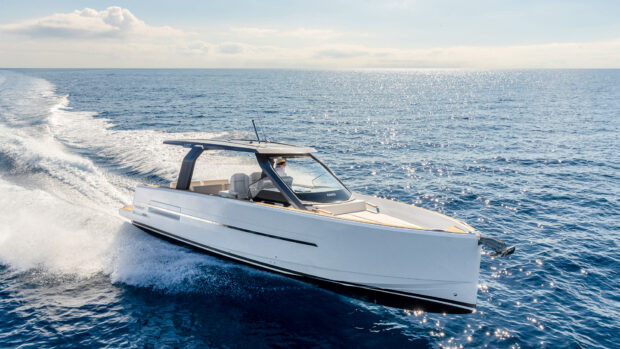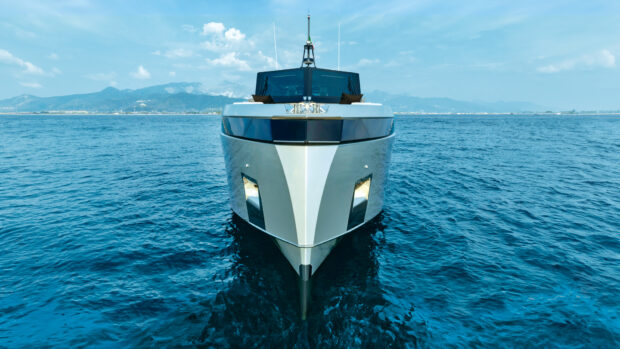When the Fairey Super Swordsman 33 was launched, Fairey Marine was reportedly the largest boat builder outside the US. But does this 33 footer hold up today?
Sometimes you hear them before you see them; the throaty growl of their engines preceding their appearance in a marina or bay. Other times, their classically sleek lines will catch the eye before they dart gracefully by. But whichever way you encounter them, one thing’s for sure; once seen – or heard – there’s no forgetting Fairey’s motor yachts, each one a shining example of living history if ever there was one.
While some modern boaters may find the attraction hard to appreciate, aficionados revel in the joys of a brand which can trace its long and impressive heritage all the way back to 1915 when Charles Richard Fairey founded his company and established a base at Hamble Point, where the River Hamble meets Southampton Water.

Fairey Super Swordsman 33
Impressive history
At the time, Charles (later known as Sir Richard), was looking to the skies as much as the water, for under the name Fairey Aviation his Hamble operation focused on the assembly and testing of seaplanes.
Over the years, many aero-successes would follow, including the 1,000+mph world speed record breaking Fairey Delta 2, the vertical take-off Rotodyne airliner, and the Fairey Gannet, which featured foldable wings for storage aboard aircraft carriers. For the boating community, however, the attention-grabbing headline was written in 1946 when Fairey Marine was created.
Initially, the marine arm of the business mass produced sailing dinghies at the Hamble factory before adding outboard-powered and shaft-drive open boats to its portfolio in 1957. It was during this year that naval architect Alan V Burnard, whose designs would grace the brand for many years to come, joined the iconic company.
Key to Fairey’s success was the hot moulding process it employed for its wooden hulls. Originally devised for aircraft component production, hot moulding saw up to nine layers of lamination applied to a one-piece plywood shell. The entire assembly was then baked under pressure to cure the glue. Crucially, the form of the product was maintained throughout the process, resulting in hulls which were not only robust and durable, but also reliably uniform in shape.

The aft cabin design restricts the size of the cockpit but the helming experience is pure joy
Among the many Burnard-designed vessels produced by Fairey was the subject of this feature, the Super Swordsman 33. Launched in 1972 as the successor to the Swordsman (of which 56 were built between 1963 and 1974), a total of 14 Super Swordsman 33s were constructed before production ceased in 1977.
While both the Swordsman and the Super Swordsman could be specified in various accommodation formats, the Super Swordsman ended up being defined by its full-height aft cabin – every example built had one. It also incorporated a higher level of trim and fit-out than its predecessor.
Perhaps there can be no higher accolade for a boat than to note that the Super Swordsman we feature here, a 1973 model being offered by Lymington-based Berthon International for £50,000, has only had one owner from new – there can be few boats that have remained in the same hands for more than half a century.
In many ways, this longevity of ownership reveals the mindset of Fairey boaters; from our conversations with several we concluded they regard themselves as much custodians as owners, and their charges as fine works of art. That goes some way to explaining why some gloriously preserved examples, which have doubtless been doted upon like a pet poodle by its lovestruck owner, can command up to £135,000 in today’s used marketplace.

Traditional Morse throttles and vertical wheel are part of this thoroughbred’s driving appeal
Shabby chic
But our review boat is not one of those; it sits towards the other end of the spectrum and is now calling out for some TLC after 50 years of use. It’s largely original interior is probably best described as shabby chic, which the Oxford Languages dictionary defines as featuring “furniture and soft furnishings that are, or appear to be, pleasingly old and slightly worn”.
In reality, this means attention is required in several areas; the seat coverings and mattresses need renewing while facets such as the interior woodwork and heads would benefit from refurbishment. The hull, however, appears to be in generally good condition – due in no small part, we suspect, to a regular maintenance regime and the quality sealed in by Fairey’s hot-moulding process described earlier.

The main saloon and galley could do with a refresh but the layout works well
In addition to generous headroom, the aft cabin, which is accessed by its own companionway to the rear of the cockpit, also allowed for an ensuite heads fitted with toilet, washbasin and shower. The day heads, however, which is located between the main saloon and the boat’s forward vee-berth cabin, only offers a toilet and a wash basin. The saloon provides a cosy below-decks seating area with room for a free standing table, and incorporates the galley, which although dated provides plenty of space for food preparation and storage.
But it’s up on deck in the wide open cockpit where this boat really comes alive. Three individual seats – two port-mounted for the helm and navigator, and the third to starboard – give it the looks and feel of a race boat and provide a full wind-in-the-hair experience for those fortunate enough to be seated in them. The helm features a vertical ship’s wheel and delightfully retro controls – a profusion of analogue gauges and toggle switches identified by big, bold Bakelite-style labels straight out of a Quatermass movie!

Access to the aft cabin is via these varnished wooden doors in the cockpit
Propelled by twin 225hp Sabre Marine marinised Perkins engines, our review boat claims a 30-knot top speed at which it consumes 22 gallons of diesel per hour. Other Super Swordsman engine choices included twin 180 or 210hp units, the standard being the more frugal (17 gallons/hour) Ford Mermaid 2704 ETs rated at 180hp, with 210 or 225hp variants of the same unit offered as options.
Totally unique
So what’s it like to own a Fairey? One man who knows the marque well, and regularly hosts them at his Bembridge marina, is the harbour’s owner, Malcolm Thorpe: “To me, the Fairey brand is all about sports powerboats with accommodation, that are all worth restoring and maintaining as nothing like them has been made since,” he says. “Personally, I owned a 30ft Spearfish about 15 years ago and regretted selling her the day I sold her!

Saloon sofa could easily be updated by reupholstering
She looked magnificent and went like a rocket with a max speed in the top 30s and a minimum of 7+ at tick-over – so hard work in marinas and harbours! At full bore the exhaust note was on a par with any F1 racing car!”
Equally effusive is owner Paul Sanders, who with wife Heather has owned Tabasco, their Super Swordsman 33, for the past eight years: “They’re unbelievable sea boats,” says Paul. “Every year we leave our Gweek Classic Boatyard base in Cornwall and go to Scilly, living aboard once we get there – which we find absolutely fine.
“It’s not always the easiest journey and it can get quite bumpy going across. In fact, we’ve been there in some pretty awful weather but the boat handles it well, no problem. I wouldn’t call it a deep-V hull, but it’s certainly a good medium V that flares out nicely to the chines. And you’ve got this amazing buoyancy.

Alan Burnard’s timeless design and deep vee hull shape still looks the part and delivers out at sea
When you first go down the classic boat route, you’re a bit suspicious and you see this wave coming and you think ‘oops’ and then suddenly you realise the boat just pulls itself out beautifully over the top – it doesn’t dig in like those modern pointy things! It’s a wonderful ride. And you know what – it’s the only motorboat I’ve ever owned where yachtsmen come up to me and say I love your boat.”
Snap up a bargain
Another point Paul remarked on was the dependability of good old-fashioned engines: “Some people we knew in Scilly went to go back to the southeast in their two-and-a-half-year-old boat. They got as far as Dartmouth, where the engine went into limp-home mode. They couldn’t get it fixed there and it subsequently cost them a fortune to repair a very, very temperamental engine.

The vee berth in the forward cabin works well for overnight guests of all ages
You hear more and more of that nowadays, because they’re basically auto engines which have been put into boats and they just do not get on with sea water. But in our classic boat we’ve got a pair of 215hp Ford Mermaid Majestics – and as long as you do the basics right with the mechanics they just go on and on.”
Paul’s final comment to us was that he would advise prospective purchasers to buy the best boat they can, with any required refurbishment already taken care of. While that’s sound advice for those seeking to get out on the water as quickly as possible, at just £50,000 our review boat offers an enormous amount of scope and the potential to snap up a part of our maritime heritage at a bargain-basement price. So, just as in the modern day boat market the same principle applies; as always, it’s a matter of you pays your money…

The aft cabin gives owners and guests their own privacy
Fairey Super Swordsman 33 specifications
MODEL: Super Swordsman
DESIGNER: Alan V Burnard
HULL TYPE: Planing
RCD: Exempt
LOA: 33ft (10m)
BEAM: 11ft 5in (3.48m)
DRAFT: 3ft (0.9m)
DISPLACEMENT: 6,600kg
FUEL CAPACITY: 2 x 455l
WATER CAPACITY: 225l
TOP SPEED: 30 knots
FUEL CONSUMPTION: 3.34l/nm @ 30 knots
RANGE: 231.34nm at 26 knots with 20% reserve
 If you enjoyed this….
If you enjoyed this….
Motor Boat & Yachting is the world’s leading magazine for Motoryacht enthusiasts. Every month we have inspirational adventures and practical features to help you realise your sailing dreams, as well as tests and news of all the latest motorboats.
Plus you’ll get our quarterly Custom Yachting supplement where we share the last on offer in the superyacht world and at the luxury end of the market.
Build your knowledge with a subscription delivered to your door. See our latest offers and save at least 30% off the cover price.
Price as reviewed:
£50,000.00 From





 If you enjoyed this….
If you enjoyed this….





